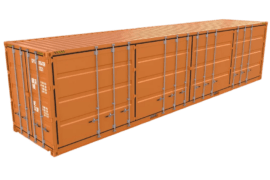Plastic pallets are now essential to sustainable and environmentally friendly supply chain management (GSCM). Environmentalists, distributors, and economists back them due to their effectiveness, durability, and affordability. Today, hundreds of businesses around the world produce plastic pallets. In contrast to wooden pallets, plastic pallets come in various designs, sizes, and features. The definitive buyer’s guide to plastic pallets is provided here to assist you in selecting the best plastic pallets for your business. FAVOS Plastic Packaging is best for packing plastic pallets.
Pallets “rackable” or “rack-compatible” are frequently referred to as having structurally supported runners along their length. Rackable pallets can span the width of industrial storage racks and shelving because they have skid runners instead of feet. Rackable pallets can, of course, also be stacked or placed directly on the floor. Although rackable pallets typically rank among the most robust options available, this strength naturally comes at the expense of additional weight and material costs. They are ideal for general product storage, retail stores, warehouses, and rack storage.
Numerous plastic pallets have a significant advantage over conventional wood pallets because they can be nested. When empty, these pallets nest inside each other thanks to their concave, cupped feet. This nesting saves money on return shipping and storage due to its incredible space efficiency. When nested inside another pallet, a nestable pallet typically requires less than an inch of vertical space, whereas a traditional wood pallet may require more than six inches. This indicates that while a dozen wood pallets can take up to six feet of vertical space, more than sixty nestable pallets can fill the same area.
The term “stackable” appears in numerous descriptions of plastic pallets. This indicates that those pallets have features that make stacking them safe and secure. These features’ designs can vary. Because of their cupped feet, nestable pallets can be stacked indefinitely. A small lip or edge on the top of a pallet may match a corresponding groove or slot on the bottom of other stackable designs. The deck tops of more advanced plastic pallet designs may interlock with the bottom runners of different pallets. Pallets that securely stack together, regardless of the design techniques used, help to eliminate the clutter and dangers associated with shaky wooden pallet stacks.
Lightweight pallets are frequently called “one-way” or “export” pallets. Reduced freight and packaging costs result from these minimalist plastic pallets’ low cost and lightweight. However, don’t mistake their sleek appearance for weakness. Plastic export pallets typically have a capacity comparable to or greater than conventional wood GMA pallets (4,600 lbs.). However, plastic pallets frequently have lower weights. Plastic pallets’ resistance to moisture and contaminants can also help reduce product spoilage, and customs issues brought on by infested wood pallets.
Pallets with solid-surface tops are known as closed deck pallets. These decks give the cargo’s bottom a smooth surface, ideal for delicate goods. They prevent contents from sagging or falling through the pallet and reduce surface abrasion. There are some closed-deck pallets with built-in structural or functional features. Non-slip materials, drainage holes, strap restraints, and other features are examples. By visiting the official site, you can view more content on pallets.
Vented deck pallets are a hybrid of closed and open deck pallets that typically have smooth top faces and several ventilation holes, slits, or grooves. The contents’ bottoms are shielded from damage by these vents, which also permit product drainage and airflow. This helps control the contents’ gaseous exposure, pressure, moisture, and temperature. Industries dealing with food processing, paper goods, textiles, building materials, and wet conditions favor ventilated deck pallets.
Pallets with open decks have few points where people can touch the surface. They typically provide structural support through a grid or web-based design, but they remain available from top to bottom. Weight is reduced, and unparalleled visual access, tie-down points, drainage, and ventilation are provided without a solid deck. Exports, packaged goods, agricultural produce, and machinery frequently use open deck pallets.
Pallets (or skids) rental and purchase should be more frequently noticed or appreciated details. On the other hand, pallets are helpful and often necessary for businesses to meet standards and achieve success.
Heat-treated wood products are used to build basic pallets, which are box-shaped. Each pallet has specially measured openings to facilitate transport by forklift, pallet jack, front loader, or other devices. For shipments, strapping, stretch, or shrink wrap are frequently used to secure a load on a pallet. The most widely used pallet in North America is a square 42 inches by 42 inches for the grocery industry, even though the dimensions of a pallet differ from country to country and location to location. The square shape of the pallet prevents the load from tipping and ensures its stability. Other dimensions are utilized to accommodate loading dock doors, train car doors, openings for additional storage containers, or to meet warehouse specifications. When required, pallets can also be designed to fit through standard doorways. Pallet manufacturers can tailor each pallet to the specific requirements of their clients.
Galvanized metals, aluminum, engineered wood products like plywood or particle board, hard plastic, and even paper are used to make other pallets. Storage, transport, and stability are all considerations in the design of each type. Different regulations apply based on the pallet’s intended use.
The initial purpose of the pallet was to facilitate the international import and export of various goods. The introduction of “palletization” significantly impacted the military because putting interest on pallets freed up men for other duties. The pallet industry grew along with the demand for secure and dependable cargo transportation. Wikipedia has a large content of pallets and their packaging, so you can choose one of these. The pallet industry is now the standard for shipping, transporting cargo, and importing international goods.






